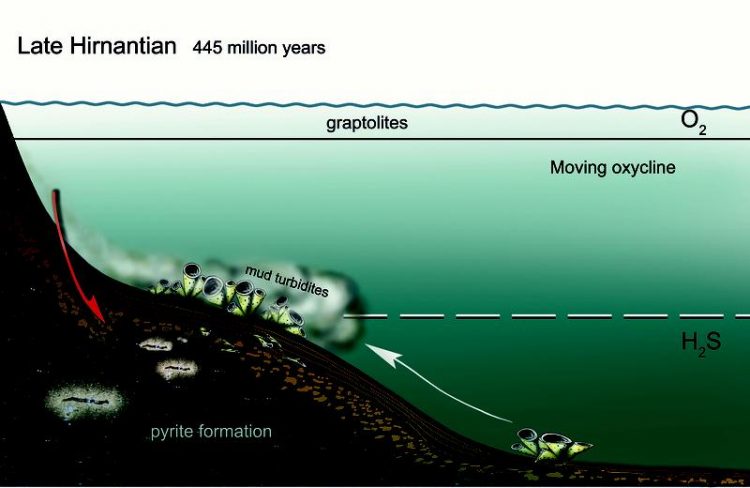Fossil deep water sponges are similar to modern sponge assemblages

Conceptual model of migration of sponges to relatively shallow water to escape from anoxic and sulphidic water (white arrow) and burial by mud turbidites (red arrow). Image: Lixia Li und Joachim Reitner
Fossils and sediments from deep sea zones of some thousand meters are extremely rare. Therefore, biodiversity and evolution of life in those zones are rarely explored. A German-Chinese team of scientists with participation from Göttingen University has analysed about 445 million year old shale sediments in Anhui province, South China.
The scientists found fossil sponge assemblages which migrated from deep water to higher ecological sea zones and which are similar to modern deep sea sponges. The results were published in Scientific Reports.
The great ice-age 445 million years ago resulted in massive ecological changes and a mass extinction of marine life. With the start of the so called recovery, the deep water sponge assemblages moved to a much higher located zone with relatively shallow water, the shelf.
“We assume that the sponges escaped from the then anoxic and sulphidic deep water”, Göttingen geobiologist Prof. Dr. Joachim Reitner says. In addition, on the shelf the sponges were buried rapidly by mud turbidities. Due to migration and burial the fossils in the analysed sediments are well-preserved, so that the scientists are the first to record sponge fossils in China.
The fossils match with modern deep water sponge assemblage. The observed assemblage is dominated by lyssakine “soft” hexactinellids (60 percent) that are typically found in deep zones of the sea. Some of them match morphologically with modern Rosella-types often found in Antarctic deep water.
Modern characteristics were found in a second group of sponges found by the scientists called demospongiae.
“These many matches show the extreme steadiness of ecological zones in deep water. This explains why the evolution of organism assemblages is slow”, Prof. Reitner says. “After the total recovery of the ecosystem the sponges re-moved to deep water zones. Those temporary movements in ecological zones are also known from other mass extinctions.”
The geobiological research in South China is a cooperation of the Faculty of Geosciences and Geography, Department of Geobiology, of Göttingen University with the Nanjing Institute of Geology and Palaeontology of the Chinese Academy of Science and the School of Earth Sciences and Engineering of Nanjing University. The research project was embedded in the “Göttingen-Nanjing Geobiology Lectures” to promote research-led teaching.
Original publication:
Lixia Li, Hongzhen Feng, Dorte Janussen, Joachim Reitner (2015): Unusual Deep Water sponge assemblage in South China – Witness of the end-Ordovician mass extinction. Scientific Reports, 5:16060, doi: 10.1038/srep16060, http://www.nature.com/articles/srep16060
Contact address:
Prof. Dr. Joachim Reitner
University of Göttingen
Faculty of Geosciences and Geography – Geobiology
Goldschmidtstrasse 3, 37073 Göttingen
Phone: +49 (0)551 39-7950
Mail: jreitne@gwdg.de
Website: www.geobiologie.uni-goettingen.de
http://www.nature.com/articles/srep16060
http://www.geobiologie.uni-goettingen.de
Media Contact
All latest news from the category: Earth Sciences
Earth Sciences (also referred to as Geosciences), which deals with basic issues surrounding our planet, plays a vital role in the area of energy and raw materials supply.
Earth Sciences comprises subjects such as geology, geography, geological informatics, paleontology, mineralogy, petrography, crystallography, geophysics, geodesy, glaciology, cartography, photogrammetry, meteorology and seismology, early-warning systems, earthquake research and polar research.
Newest articles

Superradiant atoms could push the boundaries of how precisely time can be measured
Superradiant atoms can help us measure time more precisely than ever. In a new study, researchers from the University of Copenhagen present a new method for measuring the time interval,…

Ion thermoelectric conversion devices for near room temperature
The electrode sheet of the thermoelectric device consists of ionic hydrogel, which is sandwiched between the electrodes to form, and the Prussian blue on the electrode undergoes a redox reaction…

Zap Energy achieves 37-million-degree temperatures in a compact device
New publication reports record electron temperatures for a small-scale, sheared-flow-stabilized Z-pinch fusion device. In the nine decades since humans first produced fusion reactions, only a few fusion technologies have demonstrated…





















